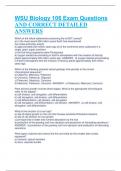WSU Biology 106 Exam Questions AND CORRECT DETAILED ANSWERS Which of the follow statements concerning the is NOT correct? a) in the most -recent 550 million years Earth has experienced five mass -extinction events b) approximately 250 million years ago all of the continents were coalesced in a single, giant, super continent c) the first living organisms were Prokaryotes d) oxygen started accumulating in Earth's atmosphere with the invasion of land by plants approximately 400 million years ago -ANSWER - d) oxygen started accumulati ng in Earth's atmosphere with the invasion of land by plants approximately 400 million years ago. Which of the following presents actual geologic time periods in the correct chronological sequence? a) Oligozoic, Mesozoic, Paleozoic b) Cenozoic, Paleozoic, Oligozoic c) Paleozoic, Mesozoic, Cenozoic d) Mesozoic, Paleozoic, Cenozoic -ANSWER - c) Paleiozoic, Mesozoic, Cenozoic Plant primary growth involves three stages. What is the appropriate chronological order of the stages? a) cell division, cell elongati on, cell differentiation b) cell elongation, cell division, cell differentiation c) cell differentiation, cell division, cell elongation d) cell elongation, cell differentiation, cell division -ANSWER - a) cell division, cell elongation, cell differentiation What is the function of a root cap? a) site of lateral growth on the root that houses symbiotic Rhizobium bacteria b) site of cell division for root growth c) principal site of water and nutrient abs orption by the root d) protection of the growing root from abrasion and production of lubricating secretions -
ANSWER - d) protection of the growing root from abrasion and production of lubricating secretions What types of plants have stems like this and w hat do the smaller dark circles represent? a) monocot, apical meristem b) dicot, vascular bundle c) monocot, vascular bundle d) dicot, apical meristem -ANSWER - c) monocot, vascular bundle The lengthening of a cell in a growing root, or shoot, requires th at the cell wall lengthen with the rest of the cell. Lengthening of the cell wall results from what process? a) new cellulose fibers are added in a band around the equator of the cell b) loosening of cellulose fibers in the wall followed by the inward move ment of water c) new cellulose fibers are added to each end of the cell wall d) dissolving of the cell wall followed by the assembly of a new wall after the cell has lengthened -ANSWER - b) loosening of cellulose fibers in the wall followed by the inward m ovement of water Moving from the outside of a tree toward the tree's center, what is the appropriate order of tissues that one would encounter? a) cork, phloem, cambium, xylem b) phloem, xylem, cambium, cork c) cambium, phloem, cork, xylem d) cork, xylem, cambium, phloem -ANSWER - a) cork, phloem, cambium, xylem Secondary phloem in a woody dicot arises from what tissue? a) lateral meristem b) cork cambium c) vascular cambium d) apical meristem -ANSWER - c) vascular cambium Which of the fol lowing is a plant micronutrient? a) N - nitrogen b) S - sulfur c) Cl - chlorine d) P - phosphorus -ANSWER - c) Cl - Chlorine Which of the following is a plant macronutrient? a) Fe - iron b) Cu - copper c) K - potassium d) Zn - zinc -ANSWER - c) K - Potass ium What is the name of the region where water and dissolved minerals move within cell walls (but not through the plasma membranes) and in the spaces between cells of the root cortex? a) mesophyll b) symplast c) apoplast d) ectomycorrhizae -ANSWER - c) ap oblast How are plant micronutrients different than macronutrients? a) micronutrients are smaller molecules than macronutrients b) micronutrients are needed in smaller quantities than macronutrients c) micronutrients are needed in larger quantities than macronutrients d) micronutrients are larger molecules than macronutrients -ANSWER - b) micronutrients are needed in smaller quantities than macronutrients Nitrogen -fixing bacteria release ammonia, NH3 , into the soil. From what source do they obtain the nitrogen needed to produce NH3? a) from the decaying organic material in the soil b) from NO3 - released into the soil by nitrifying bacteria c) from NH4 + released into the soil by ammonifying bacteria d) from N2 in the atmosphere -ANSWER - d) from N2 in the atmosphere Nutrients that are positive ions, e.g., K+ , tend to bind to negatively charged clay particles. What mechanism do plant roots use to obtain the ions from the clay particles? a) they secre te Ca2+ into the soil which bind to the clay particle and displace other ions b) they secrete Clinto the soil which competitively pull the ions away from the clay particle c) they secrete H+ into the soil which bind to the clay particle and displace other ions d) the root nodules absorb the clay particle with its attached ions into the root -
ANSWER - c) they separate H+ into the soil which bind to the clay particle and displace other ions Transpiration involves the movement of ____. a) sap from the leaves to the roots b) minerals from the soil into the roots c) water from the roots to the leaves d) water from the soil into the roots -ANSWER - c) water from the roots to the leaves Which of the following is NOT associated with the long -distance movement of sugars in plants? a) active transport of sugars b) transpiration of water out of leaf stomata c) hydrostatic pressure pushing sap through phloem tubes




